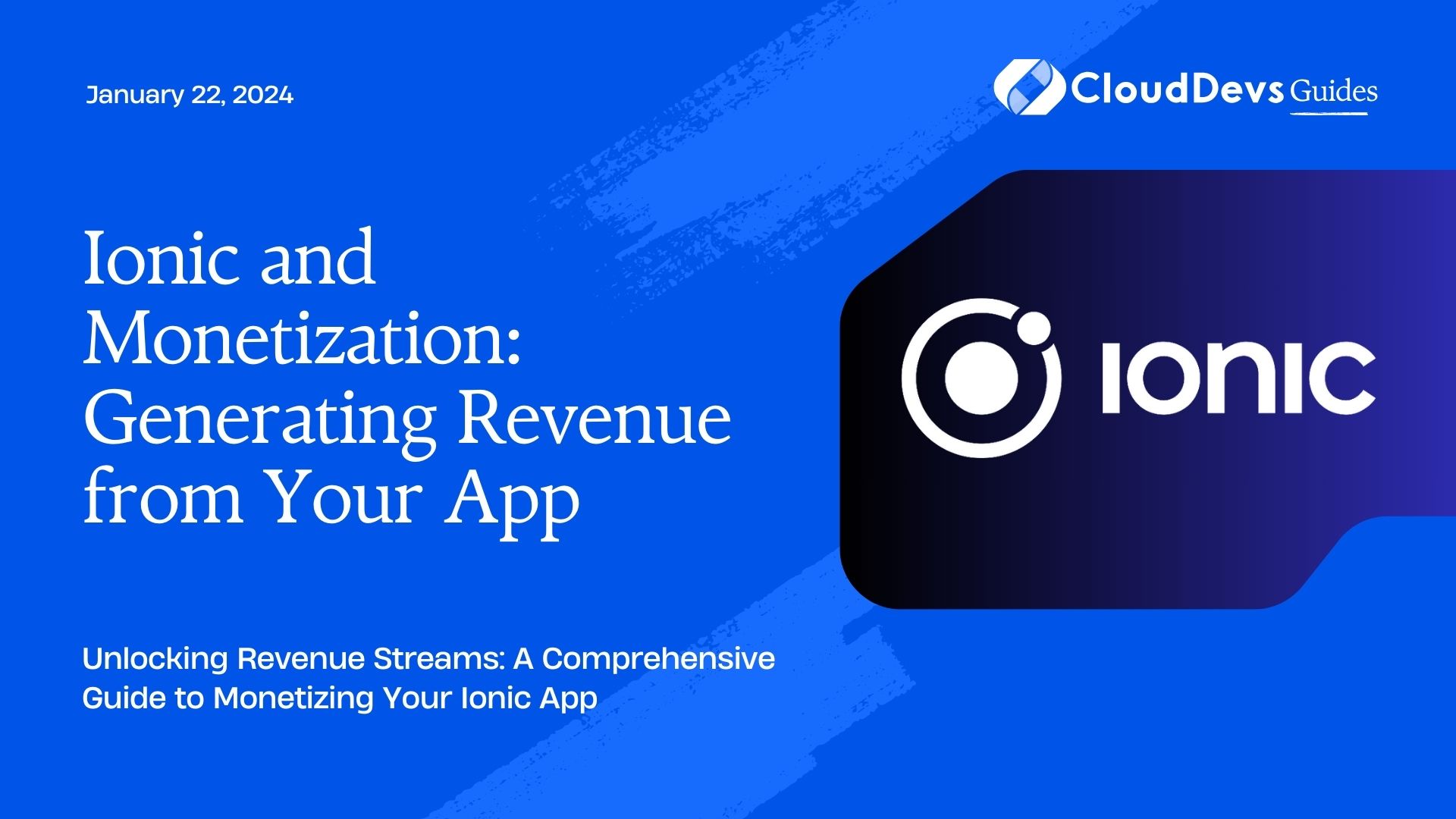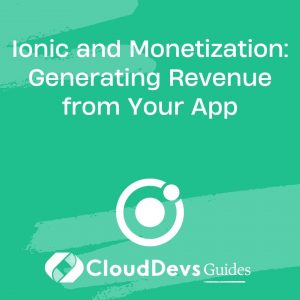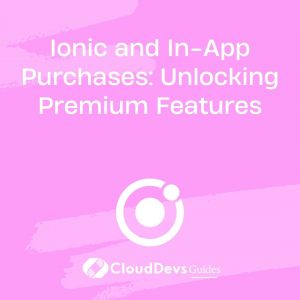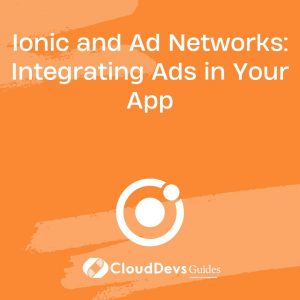Ionic and Monetization: Generating Revenue from Your App
In the ever-evolving landscape of mobile app development, creating a feature-rich and user-friendly app is just one piece of the puzzle. Once your Ionic app is ready to launch, you’ll want to explore monetization strategies to turn your hard work into revenue. Whether you’re a seasoned app developer or just getting started, this guide will walk you through various methods of generating income from your Ionic app, including ads, in-app purchases, and subscriptions.
Table of Contents
1. Understanding the Importance of Monetization
Monetization is the process of earning revenue from your app, and it’s a crucial aspect of app development. Even if your primary goal is to provide value to users, generating income from your app can help sustain its development, fund future updates, and turn your passion project into a sustainable business.
When it comes to Ionic apps, you have several options for monetization. Let’s explore some of the most effective strategies.
1.1. In-App Advertising
1.1.1. Banner Ads
Banner ads are one of the most common forms of in-app advertising. They are displayed at the top or bottom of the screen, offering a non-intrusive way to monetize your app. Integrating banner ads into your Ionic app is relatively straightforward, thanks to plugins like AdMob.
Here’s a code snippet to get you started with AdMob banner ads in your Ionic app:
javascript
// Install the AdMob plugin
ionic cordova plugin add cordova-plugin-admob-free
npm install @ionic-native/admob-free
// Import the AdMob plugin in your component
import { AdMobFree, AdMobFreeBannerConfig } from '@ionic-native/admob-free/ngx';
// Create a banner ad configuration
const bannerConfig: AdMobFreeBannerConfig = {
id: 'your-admob-banner-id',
isTesting: false,
autoShow: true,
};
// Show the banner ad
this.adMobFree.banner.config(bannerConfig);
this.adMobFree.banner.prepare()
.then(() => {
// Banner ad successfully prepared
})
.catch((error) => {
// Handle error
});
1.1.2. Interstitial Ads
Interstitial ads are full-screen ads that appear at natural breaks in your app, such as between levels in a game or when transitioning between app screens. They tend to provide higher revenue compared to banner ads but should be used sparingly to avoid annoying users.
To implement interstitial ads in your Ionic app using AdMob:
javascript
// Import the AdMob plugin in your component
import { AdMobFree, AdMobFreeInterstitialConfig } from '@ionic-native/admob-free/ngx';
// Create an interstitial ad configuration
const interstitialConfig: AdMobFreeInterstitialConfig = {
id: 'your-admob-interstitial-id',
isTesting: false,
autoShow: true,
};
// Show the interstitial ad
this.adMobFree.interstitial.config(interstitialConfig);
this.adMobFree.interstitial.prepare()
.then(() => {
// Interstitial ad successfully prepared
})
.catch((error) => {
// Handle error
});
1.2. In-App Purchases (IAPs)
In-app purchases are an excellent way to offer premium content or features within your Ionic app. You can implement two types of IAPs:
1.2.1. Consumable IAPs
Consumable IAPs are items or features that users can purchase multiple times, such as in-game currency or power-ups. To implement consumable IAPs, you’ll need to integrate a payment gateway like Stripe or PayPal into your Ionic app.
Here’s a simplified example of how to set up a consumable IAP using Ionic Native In-App Purchase:
javascript
// Install the In-App Purchase plugin
ionic cordova plugin add cc.fovea.cordova.purchase
npm install @ionic-native/in-app-purchase-2
// Import the In-App Purchase plugin in your component
import { InAppPurchase2 } from '@ionic-native/in-app-purchase-2/ngx';
// Initialize the plugin
this.iap.initialize();
// Register products
this.iap.register({
id: 'consumable-item-1',
alias: 'Consumable Item 1',
type: this.iap.CONSUMABLE
});
// Purchase a consumable item
this.iap.order('consumable-item-1')
.then((data) => {
// Item purchased successfully
})
.catch((error) => {
// Handle error
});
1.2.2. Non-Consumable IAPs
Non-consumable IAPs are one-time purchases that unlock permanent content or features in your app. This could include removing ads, unlocking premium features, or accessing exclusive content.
To implement non-consumable IAPs using Ionic Native In-App Purchase:
javascript
// Register a non-consumable product
this.iap.register({
id: 'non-consumable-item-1',
alias: 'Non-Consumable Item 1',
type: this.iap.NON_CONSUMABLE
});
// Purchase a non-consumable item
this.iap.order('non-consumable-item-1')
.then((data) => {
// Item purchased successfully
})
.catch((error) => {
// Handle error
});
1.3. Subscriptions
Subscriptions are an effective way to establish a recurring revenue stream for your Ionic app. They are commonly used for services that offer content updates, premium features, or access to exclusive communities.
To implement subscriptions, you’ll need to work with a payment gateway that supports subscription billing, such as Stripe or Apple’s in-app purchase system. Here’s a simplified example of how to set up a subscription using Stripe:
javascript
// Initialize Stripe.js with your publishable key
const stripe = Stripe('your-publishable-key');
// Create a checkout session for a subscription
stripe.redirectToCheckout({
items: [{ subscription: 'your-subscription-plan-id' }],
}).then((result) => {
if (result.error) {
// Handle error
}
});
2. Choosing the Right Monetization Strategy
Selecting the right monetization strategy for your Ionic app depends on various factors, including your app’s niche, target audience, and content. Here are some considerations to help you make an informed decision:
- User Experience: Always prioritize the user experience. Intrusive ads or excessive in-app purchases can drive users away.
- App Type: Consider the nature of your app. Games might benefit from ads and in-app purchases, while content-heavy apps may thrive with subscriptions.
- Competitor Analysis: Research your competitors to see what monetization strategies are working for them.
- User Feedback: Listen to user feedback and adjust your monetization strategy based on their preferences.
- Testing: Experiment with different strategies and analyze their performance to find the most effective approach.
3. Monetization Best Practices
Regardless of the strategy you choose, here are some best practices to maximize your app’s revenue potential:
3.1. Optimize Ad Placements
If you’re using ads, make sure to place them strategically where they won’t disrupt the user experience. A well-placed ad can generate higher click-through rates and revenue.
3.2. Offer Value
Provide value to your users, whether through premium features, exclusive content, or an ad-free experience. Users are more likely to pay when they perceive value.
3.3. Promote Your Monetization Options
Don’t be shy about promoting your monetization options within the app. Inform users about the benefits of purchasing or subscribing.
3.4. Engage Your Users
Engage with your users through push notifications, emails, or in-app messages to keep them informed about updates, promotions, and new features.
3.5. Monitor and Analyze
Regularly monitor the performance of your monetization strategy using analytics tools. Adjust your approach based on data and user behavior.
Conclusion
Monetizing your Ionic app is an essential step to ensure its sustainability and growth. Whether you choose in-app advertising, in-app purchases, or subscriptions, the key is to strike a balance between revenue generation and user satisfaction. By implementing the right monetization strategy and following best practices, you can turn your app into a successful and profitable venture. Start monetizing your app today and reap the rewards of your hard work in the world of mobile app development.
Table of Contents








